GMC SIERRA 2003 Service Manual
Manufacturer: GMC, Model Year: 2003, Model line: SIERRA, Model: GMC SIERRA 2003Pages: 408, PDF Size: 2.58 MB
Page 41 of 408
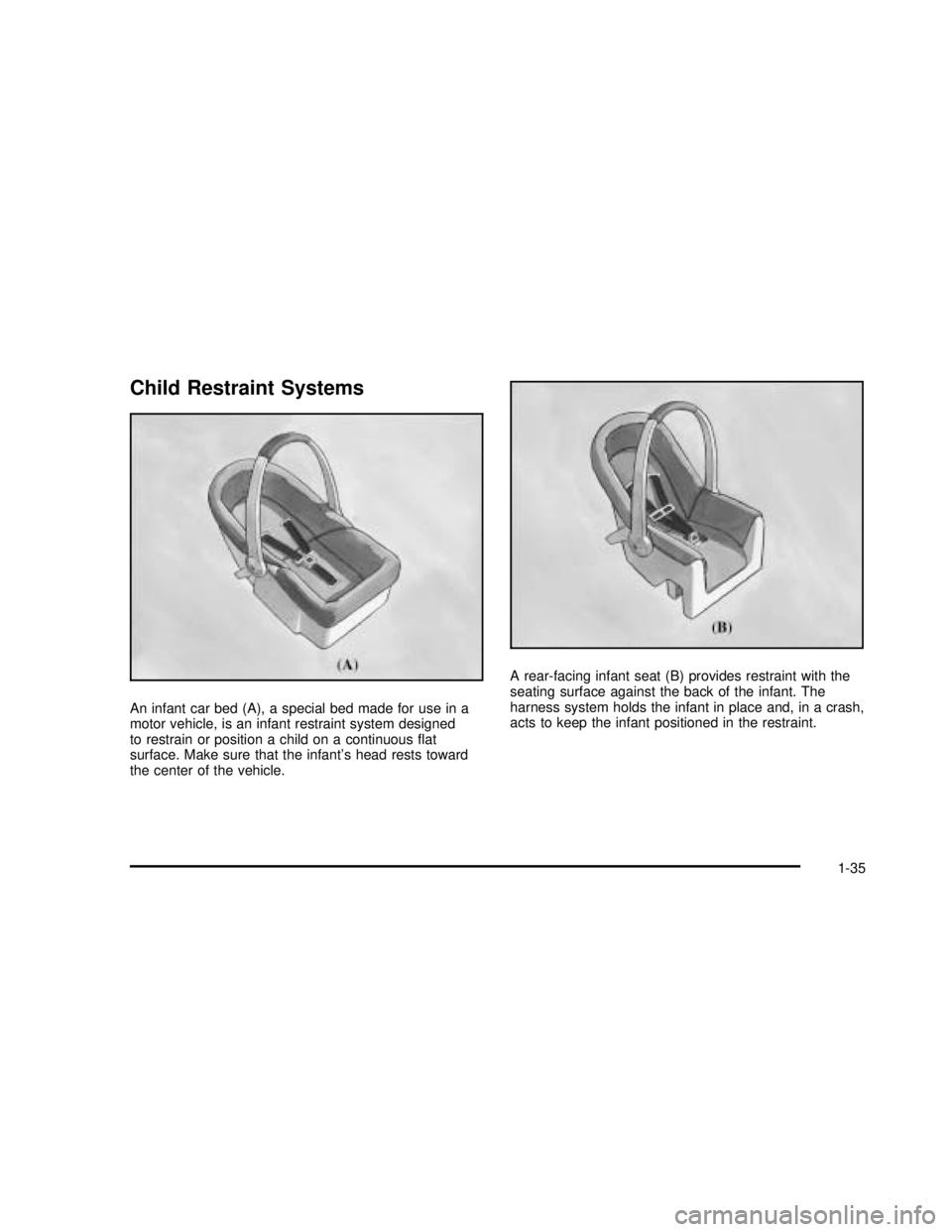
Child Restraint Systems
An infant car bed (A), a special bed made for use in a
motor vehicle, is an infant restraint system designed
to restrain or position a child on a continuousflat
surface. Make sure that the infant’s head rests toward
the center of the vehicle.A rear-facing infant seat (B) provides restraint with the
seating surface against the back of the infant. The
harness system holds the infant in place and, in a crash,
acts to keep the infant positioned in the restraint.
1-35
2003 - Sierra Denali
Page 42 of 408
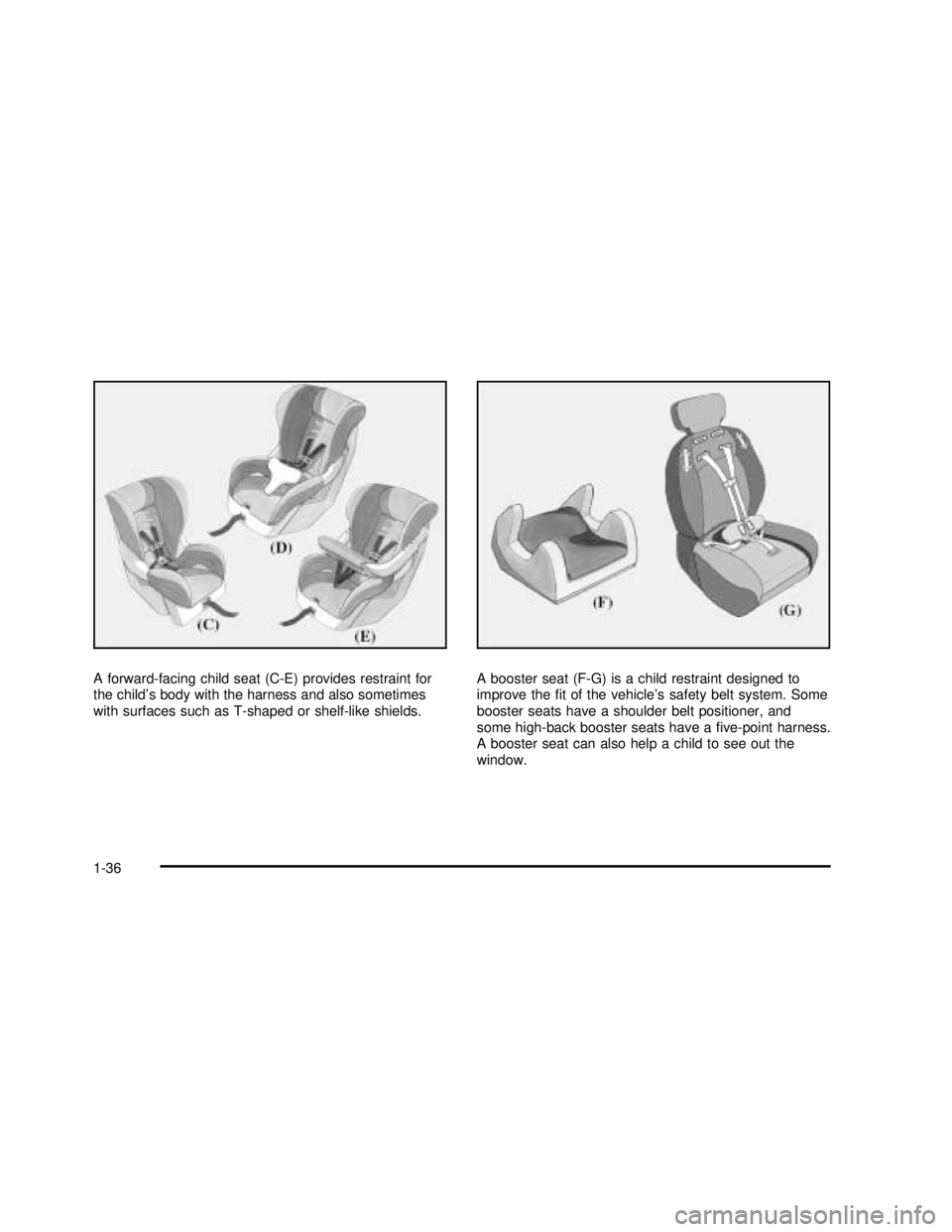
A forward-facing child seat (C-E) provides restraint for
the child’s body with the harness and also sometimes
with surfaces such as T-shaped or shelf-like shields.A booster seat (F-G) is a child restraint designed to
improve thefit of the vehicle’s safety belt system. Some
booster seats have a shoulder belt positioner, and
some high-back booster seats have afive-point harness.
A booster seat can also help a child to see out the
window.
1-36
2003 - Sierra Denali
Page 43 of 408
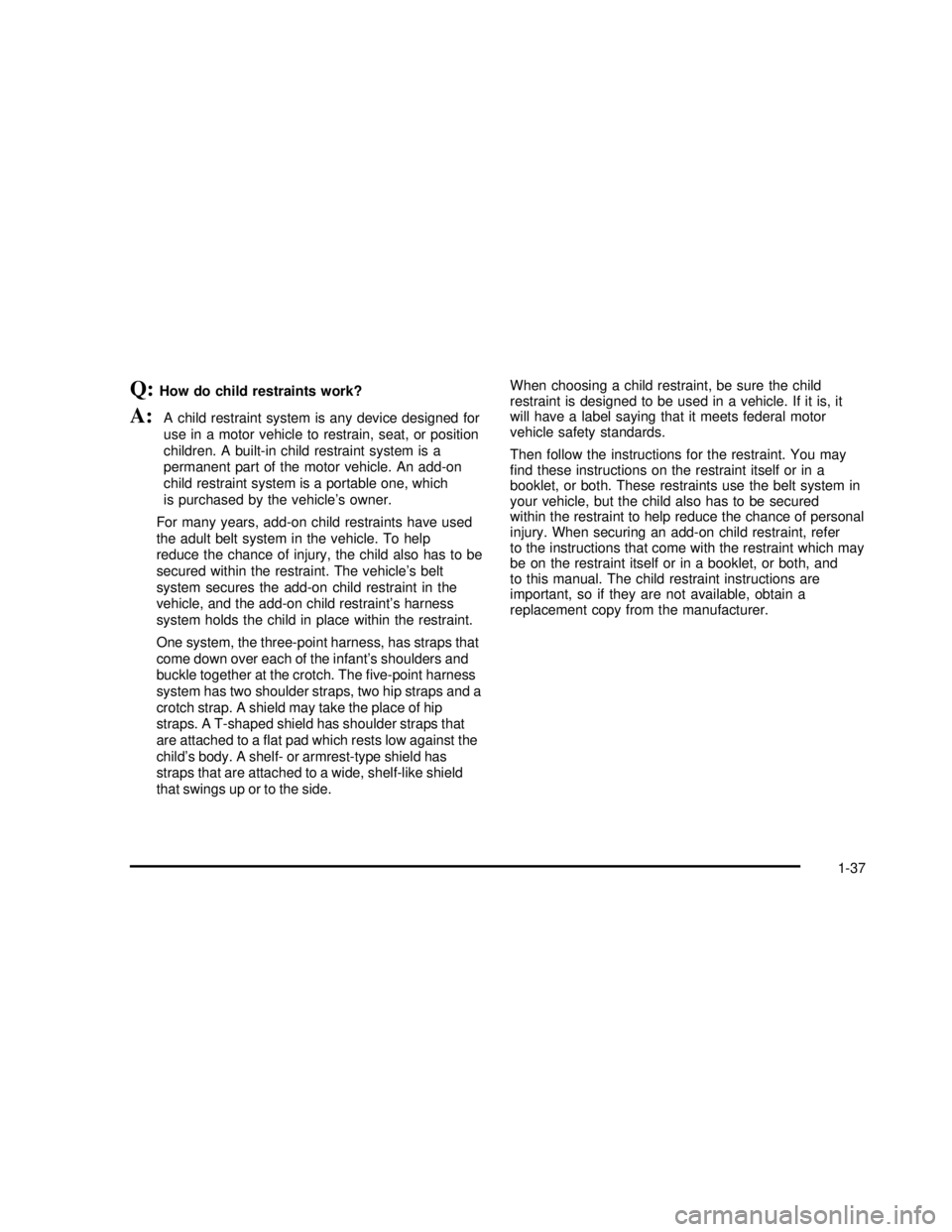
Q:How do child restraints work?
A:A child restraint system is any device designed for
use in a motor vehicle to restrain, seat, or position
children. A built-in child restraint system is a
permanent part of the motor vehicle. An add-on
child restraint system is a portable one, which
is purchased by the vehicle’s owner.
For many years, add-on child restraints have used
the adult belt system in the vehicle. To help
reduce the chance of injury, the child also has to be
secured within the restraint. The vehicle’s belt
system secures the add-on child restraint in the
vehicle, and the add-on child restraint’s harness
system holds the child in place within the restraint.
One system, the three-point harness, has straps that
come down over each of the infant’s shoulders and
buckle together at the crotch. Thefive-point harness
system has two shoulder straps, two hip straps and a
crotch strap. A shield may take the place of hip
straps. A T-shaped shield has shoulder straps that
are attached to aflat pad which rests low against the
child’s body. A shelf- or armrest-type shield has
straps that are attached to a wide, shelf-like shield
that swings up or to the side.When choosing a child restraint, be sure the child
restraint is designed to be used in a vehicle. If it is, it
will have a label saying that it meets federal motor
vehicle safety standards.
Then follow the instructions for the restraint. You may
find these instructions on the restraint itself or in a
booklet, or both. These restraints use the belt system in
your vehicle, but the child also has to be secured
within the restraint to help reduce the chance of personal
injury. When securing an add-on child restraint, refer
to the instructions that come with the restraint which may
be on the restraint itself or in a booklet, or both, and
to this manual. The child restraint instructions are
important, so if they are not available, obtain a
replacement copy from the manufacturer.
1-37
2003 - Sierra Denali
Page 44 of 408
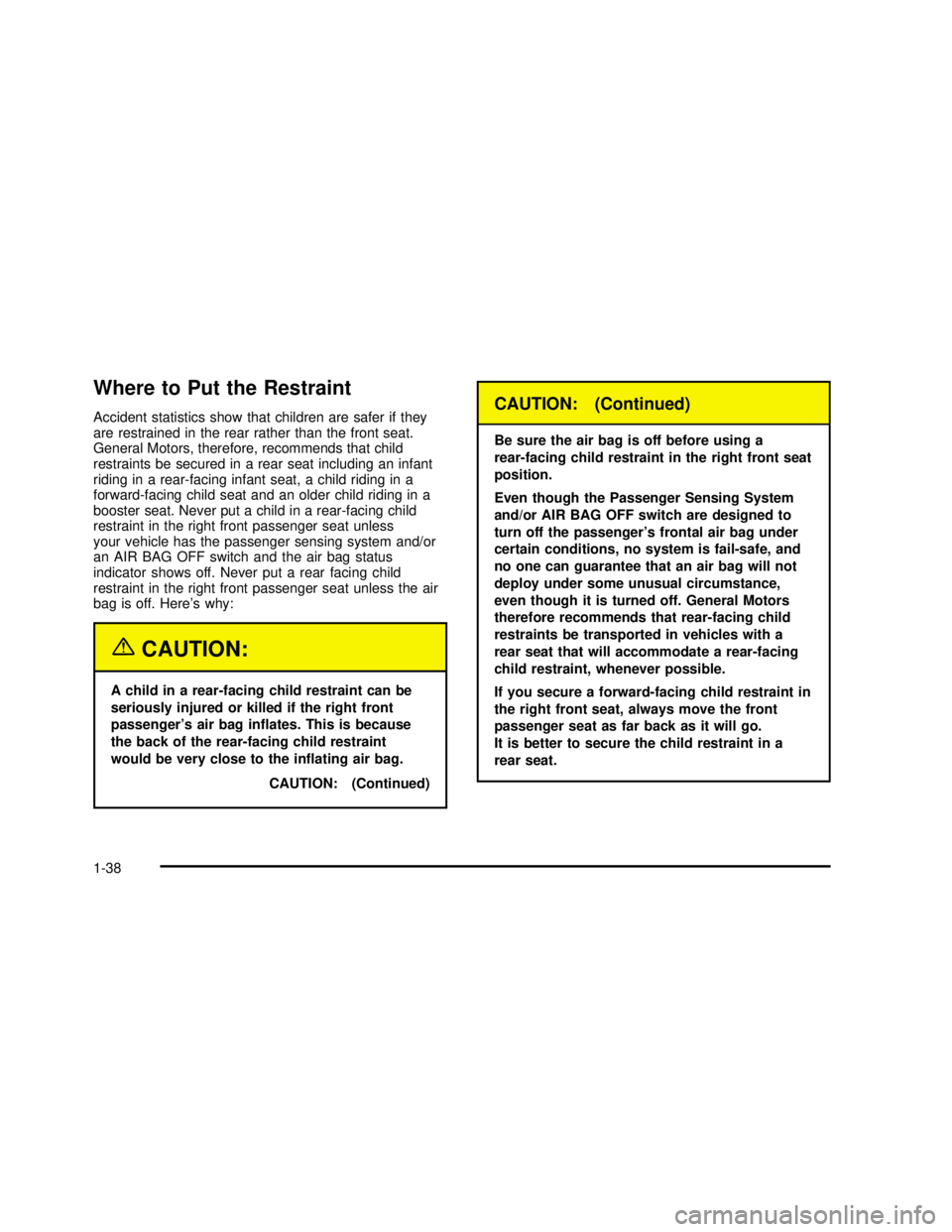
Where to Put the Restraint
Accident statistics show that children are safer if they
are restrained in the rear rather than the front seat.
General Motors, therefore, recommends that child
restraints be secured in a rear seat including an infant
riding in a rear-facing infant seat, a child riding in a
forward-facing child seat and an older child riding in a
booster seat. Never put a child in a rear-facing child
restraint in the right front passenger seat unless
your vehicle has the passenger sensing system and/or
an AIR BAG OFF switch and the air bag status
indicator shows off. Never put a rear facing child
restraint in the right front passenger seat unless the air
bag is off. Here’s why:
{CAUTION:
A child in a rear-facing child restraint can be
seriously injured or killed if the right front
passenger’s air bag inflates. This is because
the back of the rear-facing child restraint
would be very close to the inflating air bag.
CAUTION: (Continued)
CAUTION: (Continued)
Be sure the air bag is off before using a
rear-facing child restraint in the right front seat
position.
Even though the Passenger Sensing System
and/or AIR BAG OFF switch are designed to
turn off the passenger’s frontal air bag under
certain conditions, no system is fail-safe, and
no one can guarantee that an air bag will not
deploy under some unusual circumstance,
even though it is turned off. General Motors
therefore recommends that rear-facing child
restraints be transported in vehicles with a
rear seat that will accommodate a rear-facing
child restraint, whenever possible.
If you secure a forward-facing child restraint in
the right front seat, always move the front
passenger seat as far back as it will go.
It is better to secure the child restraint in a
rear seat.
1-38
2003 - Sierra Denali
Page 45 of 408
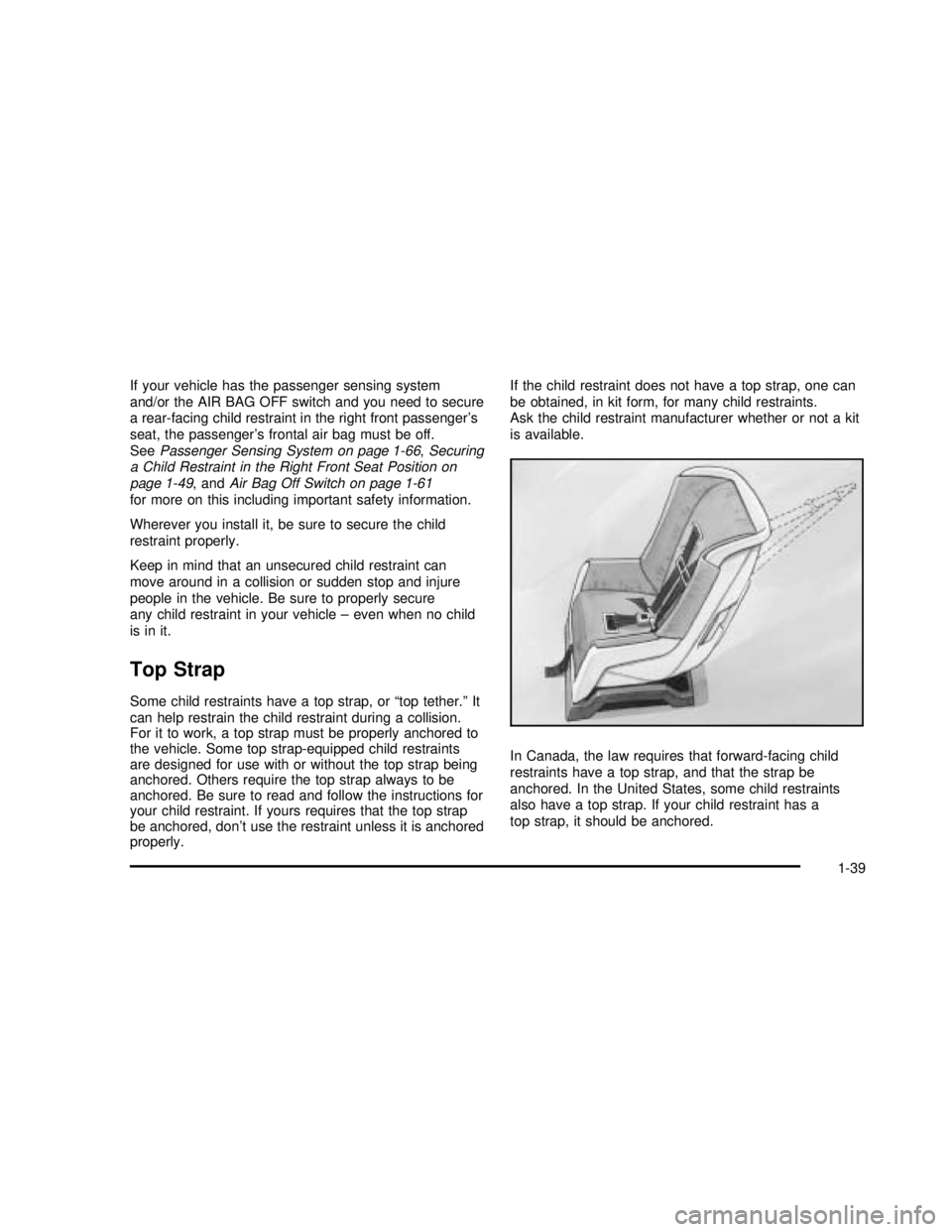
If your vehicle has the passenger sensing system
and/or the AIR BAG OFF switch and you need to secure
a rear-facing child restraint in the right front passenger’s
seat, the passenger’s frontal air bag must be off.
SeePassenger Sensing System on page 1-66,Securing
a Child Restraint in the Right Front Seat Position on
page 1-49, andAir Bag Off Switch on page 1-61
for more on this including important safety information.
Wherever you install it, be sure to secure the child
restraint properly.
Keep in mind that an unsecured child restraint can
move around in a collision or sudden stop and injure
people in the vehicle. Be sure to properly secure
any child restraint in your vehicle–even when no child
is in it.
Top Strap
Some child restraints have a top strap, or“top tether.”It
can help restrain the child restraint during a collision.
For it to work, a top strap must be properly anchored to
the vehicle. Some top strap-equipped child restraints
are designed for use with or without the top strap being
anchored. Others require the top strap always to be
anchored. Be sure to read and follow the instructions for
your child restraint. If yours requires that the top strap
be anchored, don’t use the restraint unless it is anchored
properly.If the child restraint does not have a top strap, one can
be obtained, in kit form, for many child restraints.
Ask the child restraint manufacturer whether or not a kit
is available.
In Canada, the law requires that forward-facing child
restraints have a top strap, and that the strap be
anchored. In the United States, some child restraints
also have a top strap. If your child restraint has a
top strap, it should be anchored.
1-39
2003 - Sierra Denali
Page 46 of 408
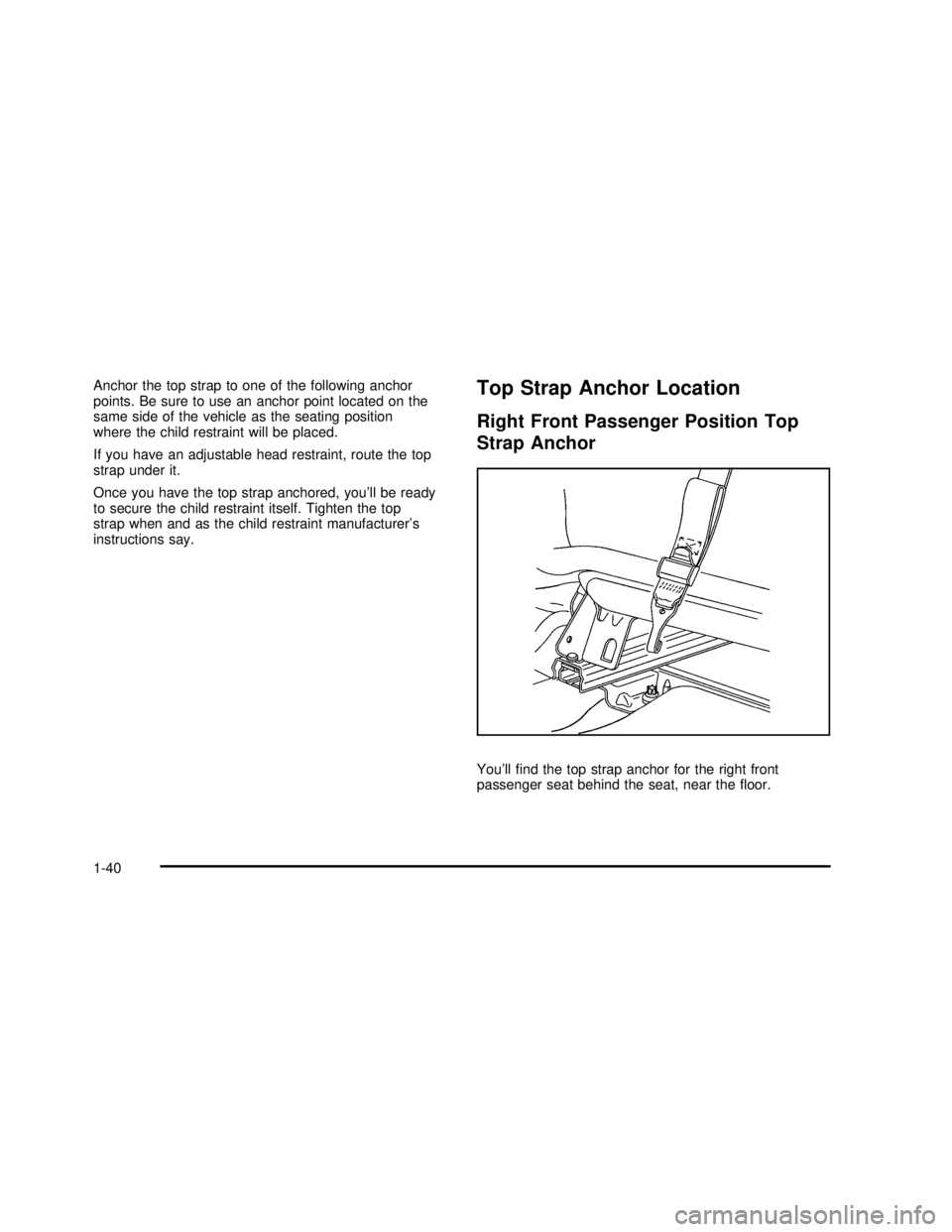
Anchor the top strap to one of the following anchor
points. Be sure to use an anchor point located on the
same side of the vehicle as the seating position
where the child restraint will be placed.
If you have an adjustable head restraint, route the top
strap under it.
Once you have the top strap anchored, you’ll be ready
to secure the child restraint itself. Tighten the top
strap when and as the child restraint manufacturer’s
instructions say.Top Strap Anchor Location
Right Front Passenger Position Top
Strap Anchor
You’llfind the top strap anchor for the right front
passenger seat behind the seat, near thefloor.
1-40
2003 - Sierra Denali
Page 47 of 408
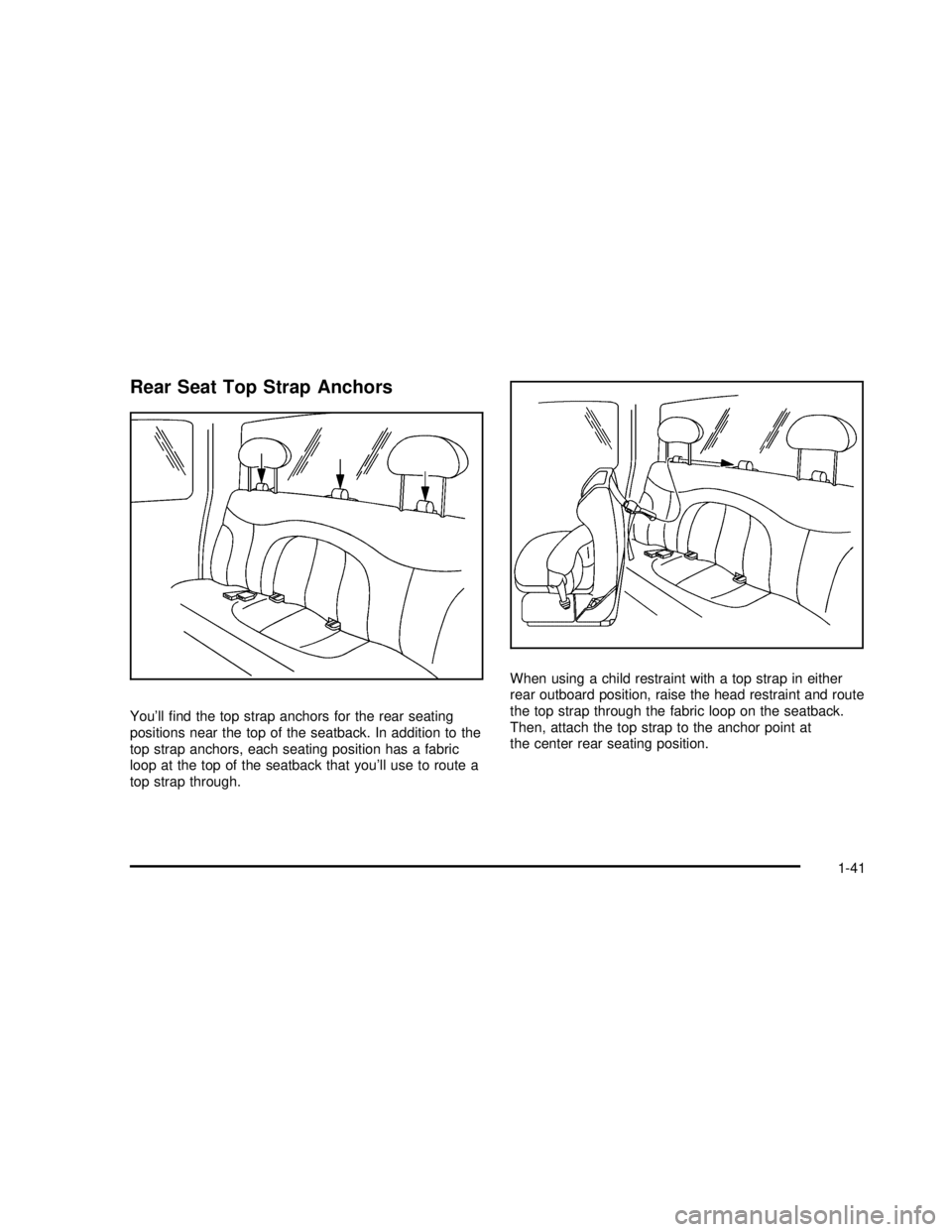
Rear Seat Top Strap Anchors
You’llfind the top strap anchors for the rear seating
positions near the top of the seatback. In addition to the
top strap anchors, each seating position has a fabric
loop at the top of the seatback that you’ll use to route a
top strap through.When using a child restraint with a top strap in either
rear outboard position, raise the head restraint and route
the top strap through the fabric loop on the seatback.
Then, attach the top strap to the anchor point at
the center rear seating position.
1-41
2003 - Sierra Denali
Page 48 of 408
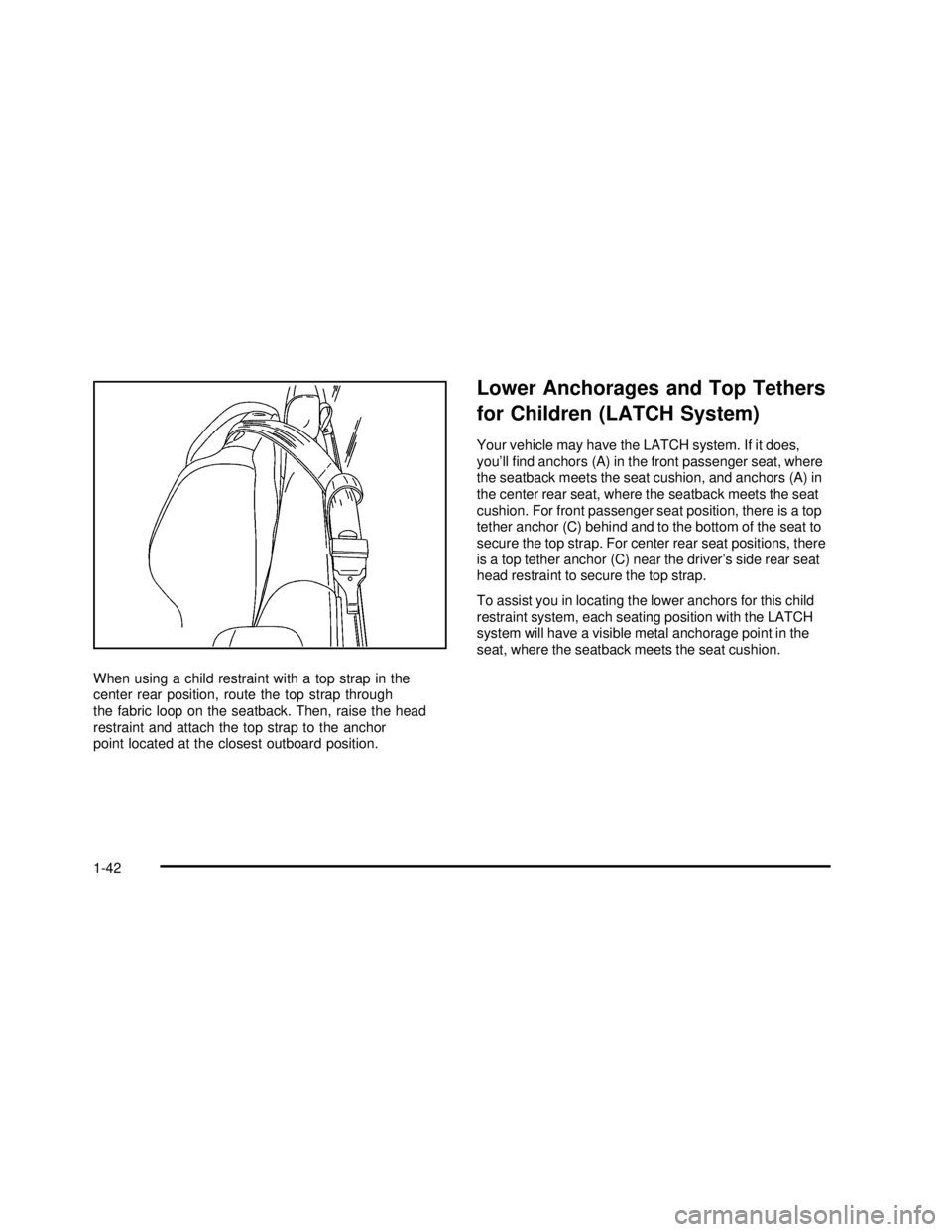
When using a child restraint with a top strap in the
center rear position, route the top strap through
the fabric loop on the seatback. Then, raise the head
restraint and attach the top strap to the anchor
point located at the closest outboard position.
Lower Anchorages and Top Tethers
for Children (LATCH System)
Your vehicle may have the LATCH system. If it does,
you’llfind anchors (A) in the front passenger seat, where
the seatback meets the seat cushion, and anchors (A) in
the center rear seat, where the seatback meets the seat
cushion. For front passenger seat position, there is a top
tether anchor (C) behind and to the bottom of the seat to
secure the top strap. For center rear seat positions, there
is a top tether anchor (C) near the driver’s side rear seat
head restraint to secure the top strap.
To assist you in locating the lower anchors for this child
restraint system, each seating position with the LATCH
system will have a visible metal anchorage point in the
seat, where the seatback meets the seat cushion.
1-42
2003 - Sierra Denali
Page 49 of 408
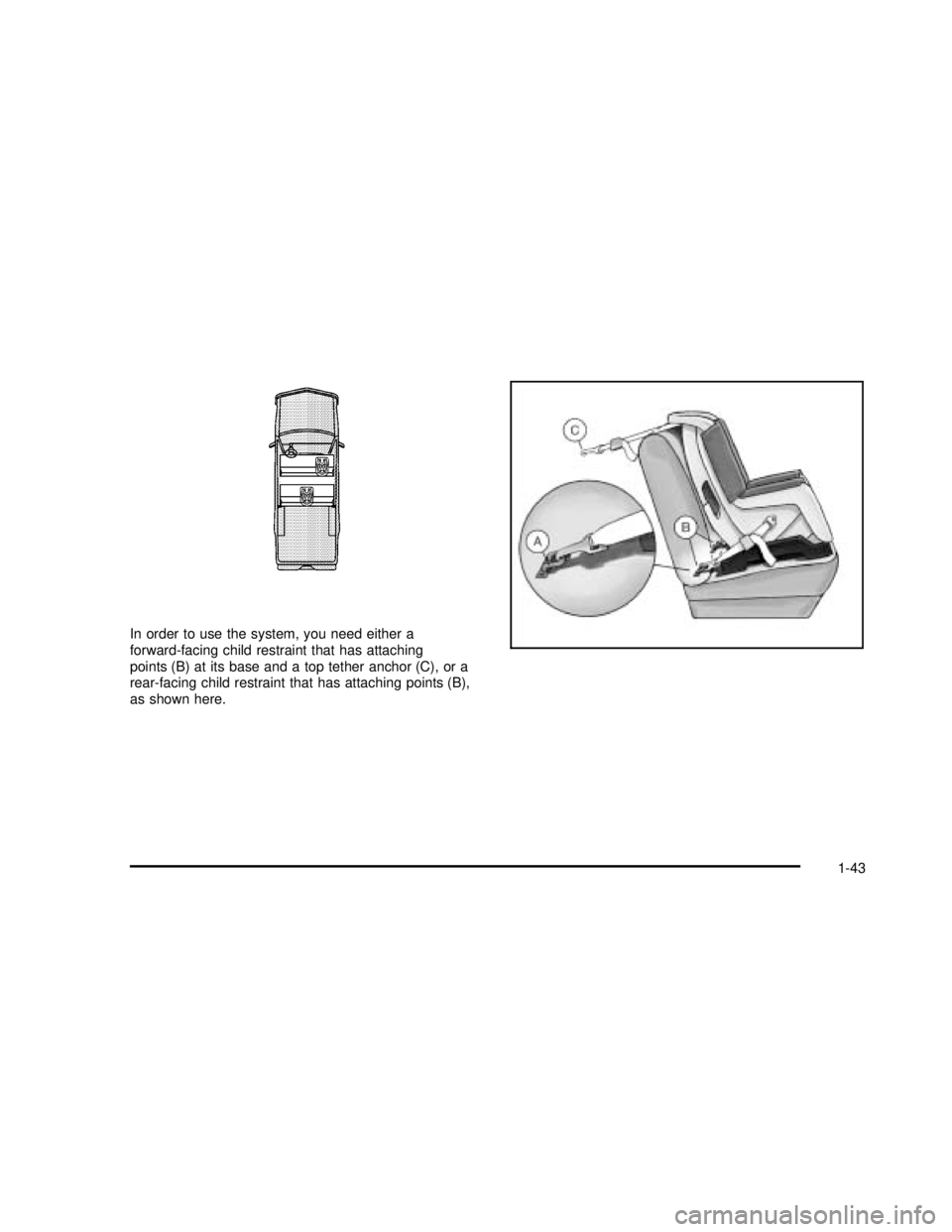
In order to use the system, you need either a
forward-facing child restraint that has attaching
points (B) at its base and a top tether anchor (C), or a
rear-facing child restraint that has attaching points (B),
as shown here.
1-43
2003 - Sierra Denali
Page 50 of 408
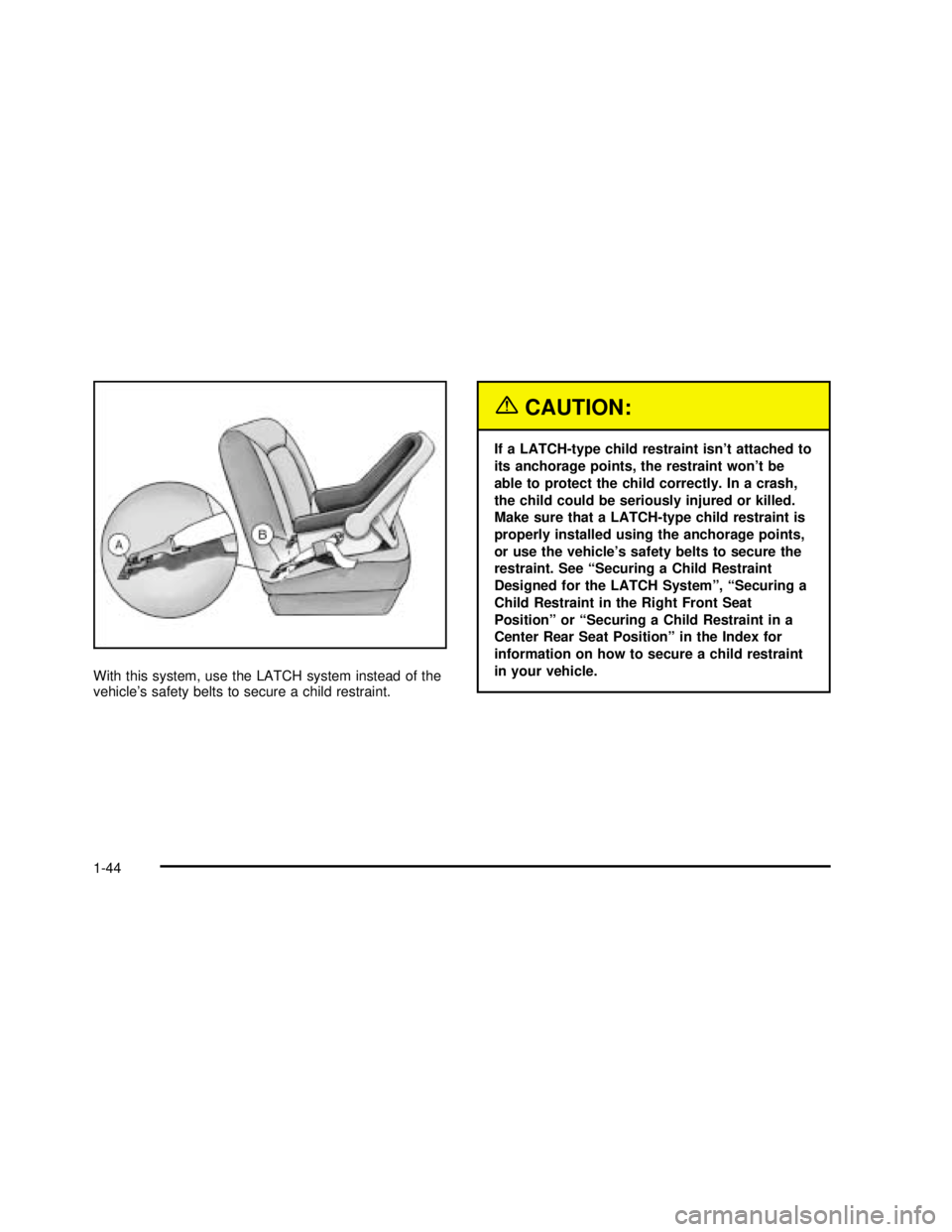
With this system, use the LATCH system instead of the
vehicle’s safety belts to secure a child restraint.
{CAUTION:
If a LATCH-type child restraint isn’t attached to
its anchorage points, the restraint won’t be
able to protect the child correctly. In a crash,
the child could be seriously injured or killed.
Make sure that a LATCH-type child restraint is
properly installed using the anchorage points,
or use the vehicle’s safety belts to secure the
restraint. See “Securing a Child Restraint
Designed for the LATCH System”, “Securing a
Child Restraint in the Right Front Seat
Position” or “Securing a Child Restraint in a
Center Rear Seat Position” in the Index for
information on how to secure a child restraint
in your vehicle.
1-44
2003 - Sierra Denali